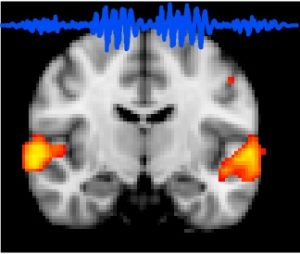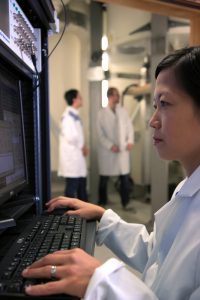The Tools
We often begin by studying behavior. Then we use functional imaging (fMRI) and/or EEG to reveal brain regions that support an evolutionarily shared behavioural ability. We then test evolutionary relationships. To assist translational medicine we combine MRI with neurophysiology to describe the neuronal mechanisms that support perceptual and cognitive abilities. This includes work with human patients by way of our neurosurgery and neurology collaborations to better understand the cognitive neurobiological bases for cognitive disorders in patients with stroke, brain degeneration, encephalitis or those undergoing treatment for cancer or epilepsy.
Research Directions
The guiding questions we are pursuing are:
I. How does perception become more than sensation? How does the brain make predictions about what will happen next?
II. What are the likely evolutionary origins of human speech and language and the neural mechanisms that support conserved abilities? Which aspects of these can find realistic animal models for complex human cognition?
III. Can the perception of communication be improved by multisensory processes or other interventions? Can we inform clinical teams with information that can help to improve diagnosis, patient stratification for treatment and the neurophysiological status of the brain cognitive system during and after neurosurgical patient treatment.
Why is this important?
I. How does perception become more than sensation?
We oeftn fogret taht waht we precieev is oeftn not phasycally tehre.
Every experience is the brain interpreting our environment, but it’s still not clear how the brain does this. We use illusions and other natural phenomena to dissociate sensation from perception and reveal how the brain shapes and stabilizes our perceptions. Also, how do cognitive abilities (like attention) assist perception and how is brain function disrupted in certain brain disorders, like dyslexia or age-related cognitive impairment?
II. What is the evolutionary and neural basis for human communication?
When the topic is human communication, most people will naturally think of human language, which is a rather unique communication system. But there is also tremendous information in our voice. For instance, we are very sensitive to human voices and we can readily recognize others by listening to their voice (except if certain parts of our brain are injured). Our vocal inflections also have emotional content which relay what we feel, and what we hope to elicit in others. This means that our communication system is fundamentally a social one, and many other social animals share the basic aspects of our vocal communication. Having made this conceptual link allows us to study the communication system of humans and other species, from each animal’s unique perspectives. This work will establish evolutionary relationships and get us closer to more satisfactory answers to really difficult questions, such as: How did human language evolve?
III. What more can we learn about human brain function by establishing further evolutionary relationships for perceptual and cognitive abilities related to communication?
Even with the best current technologies it is not possible to fully understand human brain function and dysfunction. Much of our medical science knowledge is a direct results of studies in other animals. In our work we aim to bridge the large gap between the human studies and work in animal models by using the same noninvasive brain imaging technology (fMRI) that has become the main tool for studying human brain function. These approaches and other new developments in our work with neurosurgery collaborators are indispensable for establishing evolutionary relationships that could be critical for helping medical knowledge to advance when the human studies themselves cannot answer all of our questions on how the brain works and recovers after damage.


